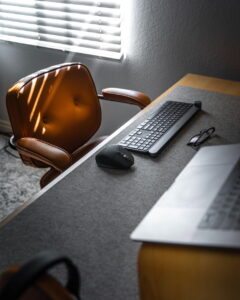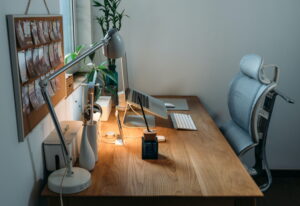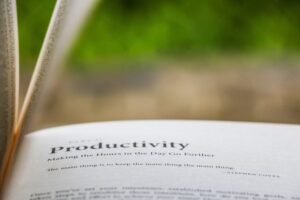 Whether you’re working from home or at the office, maintaining a healthy posture while sitting behind your desk, is key to prevent discomfort and even injury in the long run.
Whether you’re working from home or at the office, maintaining a healthy posture while sitting behind your desk, is key to prevent discomfort and even injury in the long run.
Bad posture can have a negative impact on your overall sense of well-being and can hinder your productivity.
Below are a few tips for creating a comfortable workspace, adjusted to your individual needs.
1. Keep moving!
 Try to ensure you get up and move around at least a few minutes every hour, to prevent your body from getting stuck in the same position for too long.
Try to ensure you get up and move around at least a few minutes every hour, to prevent your body from getting stuck in the same position for too long.
Our bodies are not made to stay in the same position for extended periods of time; moving around at least once per half hour ensures you keep your joints lubricated and your blood flowing.
When you get up, take a little walk, stretch your arms out and let them swing a few times, and bend your knees a few times.
Also, if you sit behind a desk all day, consider a standing desk for part of your work day. This could do wonders for your circulation and your energy levels.
2. Pay attention to the posture of your head and neck
 First and foremost, make sure your computer screen is positioned directly in front of your face, with the middle of the screen at eye level. Regardless of whether you’re working standing or sitting, always make sure your shoulders and neck are in a relaxed, comfortable position while you work.
First and foremost, make sure your computer screen is positioned directly in front of your face, with the middle of the screen at eye level. Regardless of whether you’re working standing or sitting, always make sure your shoulders and neck are in a relaxed, comfortable position while you work.
If you’re using multiple monitors, make sure they’re close enough together that you don’t have to strain your neck to switch between them. If you spend a lot of time on the phone, use a headset.
This frees up your hands for multi-tasking, keeps you from straining your neck, and even gives you the opportunity to stretch your legs while talking.
3. Remember to rest your eyes!

First of all, make sure you blink regularly. Looking at a bright screen all day is not a natural state for our eyes to be in, and it can cause stress on the eyes, which often translates to stress to the neck muscles and can cause headaches.
A good rule of thumb is the 20-20-20 principle: every 20 minutes, take a 20-second break from looking at your screen.
During those 20 seconds, look at something that’s 20 feet (about 6 meters) away from you. This relaxes your eyes by changing their focus. Another thing to consider is adapting the colours and brightness of your screen.
Make sure there’s enough contrast, and try out different brightness settings to notice how they affect your eyes.
You want to find a perfect balance where your eyes don’t need to strain, and they’re not being overloaded with bright light.
You’ll also want to light your workspace appropriately. Lighting that’s too dim or too bright can cause eye strain, which can lead to blurred vision, headaches, and neck pain. The colour of lighting can make a difference in your energy levels as well: lights with yellowish tones are easier on the eyes, where bluer tones generally create more strain.
4. Position your chair properly
 Ensure your chair is close to your desk, so your arms can be released while your hands are doing the work.
Ensure your chair is close to your desk, so your arms can be released while your hands are doing the work.
Having to stretch your arms out to reach your keyboard and mouse will make you tired more quickly.
Find a place for your keyboard and mouse where you can reach them with your elbows bent neutrally, close to your body.
Also, adjust your chair to your height. Your feet should rest comfortably on the floor while you are sitting, and your knees should be at or just below hip level.
If your seating position is too low or too high, raise or lower the chair — or get a footrest.
5. Keep your arms close
If you get uncomfortable or tired quickly while you work, you may be sitting or standing too far away from your keyboard and mouse.
When you have to stretch your arms out to type, the muscles in your neck, shoulders, arms, elbows, wrists, and hands can suffer.
You can reduce fatigue in these areas by ensuring your typing posture keeps your elbows bent at a 90-degree angle, and the weight of your arms is supported.
6. Pay attention to your general posture
This might sound simple and logical, but many people forget about their posture when they’re concentrated on their work. Ensuring the right placement of your chair, desk and screen is one thing, and on top of that it’s important not to slouch or hang in your chair.
 The back of your chair should support your upper and lower back, so scoot your hips back as far as possible into the chair and roll your chair close to your desk. Make sure your head, neck and shoulders are in a relaxed position, and your elbows remain close to your body.
The back of your chair should support your upper and lower back, so scoot your hips back as far as possible into the chair and roll your chair close to your desk. Make sure your head, neck and shoulders are in a relaxed position, and your elbows remain close to your body.
Your forearms, wrists, and hands should be in a straight line and be approximately parallel to the floor. We hope these tips will help you to feel more comfortable in your workspace, reduce fatigue and increase your productivity.
Nonica’s team offers support for workplace optimisation either at your workplace or at home; don’t hesitate to contact us with any questions!